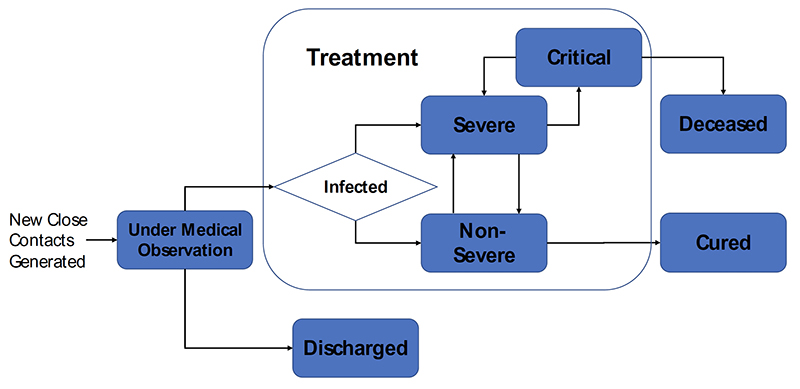 |

|
 |
Model diagram of patient state transition (self-loop transitions understood but omitted) Fig. 1 from the paper. |
|
New modeling research by Professor Michael Fu (BMGT/ISR) and academic colleagues in China is helping decisionmakers better forecast the spread of the COVID-19 pandemic. The model they describe in “Predictive Modeling for Epidemic Outbreaks” has been adopted by the Shanghai assistance medical team in Wuhan’s Jinyintan Hospital, the ?rst designated hospital in the world to take COVID-19 patients. Forecasts from the new model have been used to prepare medical sta?, intensive care unit (ICU) beds, ventilators, and other critical care medical resources, as well as to support real-time medical management decisions.
This work has just been published in the June issue of the Asia-Pacific Journal of Operational Research. Along with Fu, the paper’s authors are Jian Chen of CreditWise Technology Co., Shanghai; Wenhong Zhang, Department of Infectious Diseases, Huashan Hospital, Fundan University, Shanghai; and Junhua Zheng, School of Medicine, Jiao Tong University, Shanghai.
The need for better forecasting
During a pandemic, forecasting models are critical in helping support medical resource management decisions as well as government policies, such as when and where “lock-down” and “stay-at-home” directives should be enacted or lifted.
Existing forecasting models that are projecting the trajectory of coronavirus infection cases have made widely varying predictions of the course of the pandemic. This is because they are based on traditional epidemiology models that utilize deterministic di?erential equations to forecast the population dynamics among various states—for example, people who are “susceptible,” “exposed,” “infectious,” or “recovered.” These models are, by design, aggregates that track only mean populations and do not directly incorporate stochastic (random) e?ects. As a result, they are highly sensitive to estimated parameters.
In the COVID-19 pandemic, we often hear about a key estimated parameter called the “basic reproductive number R0.” This is the average rate at which one currently infected person infects other people. An R0 above 1 indicates the pandemic is continuing to grow; a number below 1 indicates that it is dying out. However, an inaccurate estimate of R0 is magni?ed in forecasts, leading to orders of magnitude di?erences in predictions. These in turn can result in poor decisions being made by medical and public officials.
A promising agent-based model
Recently, epidemiologists have been looking at agent-based models, familiar in the operations research community. In these models, individuals can be modeled in greater detail—such as by age, gender, health condition, and stochastic characteristics.
In the new paper, Fu and his colleagues propose a discrete-time Markov chain model— analogous to a ?nancial forecasting model—that directly incorporates stochastic behavior and for which parameter estimation is straightforward from available data. (A Markov chain is a stochastic model that describes a sequence of possible events in which the probability of each event depends only on the state attained in the previous event.)
The model provides a way to estimate parameters from available data and is computationally tractable both in terms of parameter estimation and in model output analysis.
The patient treatment process is modeled as an absorbing Markov chain (having states that, once entered, cannot be left) with the following discrete states: under medical observation, discharged, infected non-severe, infected severe, critical, deceased, and cured. The potential transitions between the states are shown in Fig. 1, where self-loops are understood but omitted in the diagram for clarity, and the three states outside the treatment boxed labeled discharged, cured and dead are absorbing states.
The researchers tested the model using data from the initial phase of the pandemic in China’s Hubei province, where Wuhan is the capital city. The model was shown to be ?exible, robust, and accurate, providing reasonably accurate forecasts, with an advantage of far less sensitivity to parameter misspeci?cation than traditional epidemiological models.
The major purpose of the model is to predict active cases—patients who are receiving treatment in medical facilities, and the patient distribution of severe/critical cases to better manage medical resources. The new approach can forecast all the states in the COVID-19 pandemic, including intermediate states (medical observation, mild cases, severe cases, critical cases), and terminal states (discharged from medical observation, cured, deceased). While the current model does not include asymptomatic cases (for which data was not available at the time), these can be readily handled by adding one more intermediate state.
The model already has been adopted by the ?rst Shanghai assistance medical team in Wuhan’s Jinyintan Hospital, where the forecasts have been used for preparing and allocating medical sta?, ICU beds, ventilators, and other critical care medical resources and for supporting medical management decisions.
A companion article to this research is set to be published in the June OR/MS Today.
Related Articles:
UMD developing COVID-19 decision making tools for colleges
Public health planners: Free resources for emergency health clinics
'OysterNet' + underwater robots will aid in accurate oyster count
Michael Fu part of $1M NSF grant to model, disrupt illicit kidney trafficking networks
Michael Fu part of NSF project to improve kidney transplant access and decision-making
NSF grant will further planning for collaborative autonomy testing infrastructure
UMD Engineers Help Pioneer New Treatment for Respiratory Failure
ISR faculty leading, playing key roles in ARL cooperative agreement
Herrmann helping UMMS design and refine vaccination clinics
'Perfect adherence' to COVID vaccine prioritization hampering distribution says Mike Ball
June 15, 2020
|

